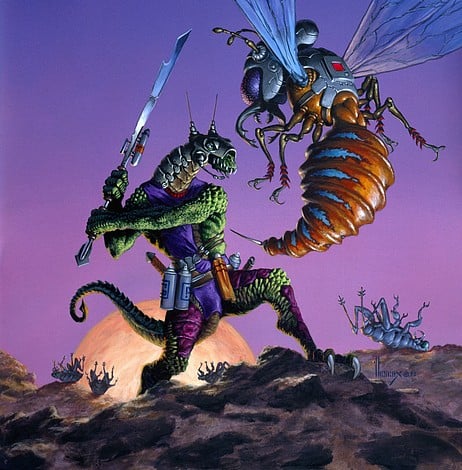- cross-posted to:
- alternativenation
- cross-posted to:
- alternativenation
Chris Knox is a great figure in the history of New Zealand music. He’s probably one of the more influential musicians in the country’s history, and he has had a hand in promoting the Indie scene of Dunedin that became an international influence. I will cover a basic history of his music career and provide some tracks for you to listen to from each.
1977-1978: The Enemy
So basically, he started in a band called the Enemy, which was one of the earliest punk bands in New Zealand (with the Suburban Reptiles and the Scavengers preceding them from Auckland) and the earliest punk band from the little southern island city of Dunedin when they started in 1977. This band was the ground zero for the indie music to come for the next two decades, as all of the major indie bands from Dunedin got their first taste of punk from the Enemy and how the band showed that anyone can pick up a guitar and write their own songs. Like the Ramones from America, or the Sex Pistols from the UK, the Enemy was the impetus for many people to create their own music. here’s some live footage of the band which, for all I know, is the only film evidence of the band.
1978-1980: Toy Love
Eventually, the Enemy dissolved after their bassist left due to being homesick from touring, so the rest of the band members regrouped, adding keyboardist Jane Walker, and formed the band Toy Love. Where the Enemy showed that anyone can start their own band, Toy Love proved that anyone could be successful at it. This band went on to perform a ton of shows around New Zealand and Auckland, playing about 500 shows in a two-year period, and would release a few influential singles, and would have chart success to boot. The band would initially sign with Elektra for a one-off single called Squeeze, and then small label Deluxe records for their next two, which include Sheep and Bride of Frankenstein, and eventually signed to the major label WEA (remember this name, you’ll understand why), and proved to be doing well for themselves. they were able to go to Australia, appear on tv shows, get good radio play, and proved to be successful in their home country. However, when it came time to record an album, WEA stepped in. They didn’t like the rough and tumble sound of the band, as they felt it wouldn’t sell, and put them in a top-of-the-line studio in Australia for the album. they record the album and it becomes a top-5 album in their native country of New Zealand, which would be good for any band. However, let’s just say the band hated the experience of recording in the top quality studio, as they felt it stripped away the bite from their sound and that creative control was taken from them by the producers. Not to mention, the move to Australia proved to be a fatal move by the band, as the constant touring and lack of success exhausted the band. Despite being one of the top bands in New Zealand, Toy love would break up in 1980. As a result of the band’s breakup, this proved to give another lesson to the Dunedin bands back in the band’s home; Never go to a major label or studio, as you will lose creative control. While this may seem like a bad outcome, the results that would come after the band’s breakup proved to be extraordinary, as Chris Knox was free from the clutches of a major label to do whatever he wanted. All it took was a TEAC 4-track recorder to do so.
1981-2009: Tall Dwarfs and the TEAC
Chris Knox would end up going back to New Zealand and reacclimating himself to the local scene into 1981. He wasn’t going to let the dissolution of Toy Love ruin his creative drive, so he set about finding a way to get his music out there. After the death of his grandmother, he received an inheritance of money and, with those funds, purchased a TEAC 4-track recorder and would experiment with new musical ideas on it. He would end up forming a band with Toy Love bandmate Alec Bathgate and they would call it Tall Dwarfs. They would prove to be a highly influential band, as they were one of the first bands to adopt the lo-fi aesthetic in their music and use home-recording techniques to make their music. They would introduce themselves to the New Zealand public with their debut EP Three Songs on Furtive records, giving the indie scene an initial offering of lo-fi goodness with songs like All my Hollowness to You making use of multi-tracking and the classic Nothings Going To Happen showing the band’s capability for great songwriting. The band would release a string of EPs and albums with songs like the brisk and wonderful Dare to Tread, the psychedelic jam Crush, and the great Sign the Dotted Line over the next few decades that would be influential on bands all over the world, with bands such as Neutral Milk Hotel citing them as a big influence. Chris Knox proved his influence once again with Tall Dwarfs, but a little label from Christchurch would end up increasing his influence even further.
1981: The Start of Flying Nun Records
Around the time of Tall Dwarfs first EP, a record store manager by the name of Roger Shepherd would decide that he was going to start his own record label after seeing the success of independent labels like Ripper Records and Propellor Records over the previous year. He would end up naming the label Flying Nun records and set about releasing music by Christchurch acts. Also around this time, the Dunedin scene was starting to be bustling with new bands and music, with bands like The Clean and The Chills gaining traction. Shepherd would end up hearing the Clean and immediately set about releasing their music. They would end up recording the single Tally Ho, and, even with the limited budget of $50 for recording, would end up getting the recording into the Top 20, putting the label in the public eye. However, they weren’t going to reach the public with rough recording quality like on Tally Ho. Enter Chris Knox into the picture. With his trusty 4-track, he would record the Clean in a church hall, with an expanded budget of $750, and came out with the record Boodle Boodle Boodle. With seminal tracks like Anything Could Happen and Point That Thing Somewhere Else, This record would turn out to be a massive success for the label, reaching the top 5 and staying in the top 40 for 6 months. This put the label on the map and let them expand their operations to other bands. Chris Knox would end up recording a lot of the early, and very influential, material on the label. This includes albums like the Dunedin Double, which gave bands like The Chills, The Verlaines, and the Sneaky Feelings their first exposure, and the early records by each of the aforementioned bands. Chris’ recordings of these bands helped to give the fledgling Flying Nun label its initial exposure and helped it to last as the premier label in New Zealand to this day. Without Chris Knox, the label may not have been able to take off. Bands like Pavement, R.E.M, and Yo La Tengo would not have been influenced by the various bands on the label that Chris Knox helped to record (listen to Box Elder by Pavement and tell me that doesn’t copy elements of the Verlaines Death and the Maiden). Chris would also prove himself further with his solo endeavors throughout the late 80s and early 90s.
1983-2000: Chris’ Solo Career
Even with Chris’s band Tall Dwarfs and his position of help at Flying Nun, he also proved to have his own great solo career alongside it all. With his home recording setup, he could record whatever he wanted from his home in Grey Lynn, Auckland. His first effort would be an lp called Songs For Cleaning Guppies from 1983, but Chris wouldn’t hit his stride with his solo career until 1989 with the album Seizure. This also includes hard-rocking indie songs like Face of Fashion, slower songs like And I Will Cry, and his all-time classic love song Not Give Lightly. Chris would continue to release great solo material into the 1990s, with albums like Croaker offering songs like Lapse and Dunno Much About Life… but I Do Know How to Breathe, Polyfoto Duck Shaped Pain & “Gum” Giving songs like Get a Life and Under The Influence, and Songs Of You & Me giving the great songs One Fell Swoop and Half Man Half Mole which was featured in an episode of Beavis and Butthead. He would also have a song called It’s love from his album Beat be featured in a well-known commercial for Heineken. His solo career just solidified the creative and innovative legacy of Chris Knox even further. Even if we didn’t get any of the previous material by Chris, this would still be enough and worth it.
2009: An unfortunate end
Unfortunately, things wouldn’t end well for the career of Chris Knox. Throughout his life, Chris suffered from epilepsy and seizures, which he would write about and would remain a consistent theme throughout his discography. This led to him having a significant lack of short-term memory, and he would have to play his music with a stand with the music on a piece of paper on stage whenever he played live. On June 11th, 2009, Chris Knox suffered a severe stroke that left the right side of his body paralyzed and his speech significantly damaged. After his stroke, artists from all over the world that were influenced by his music came together and made the album Stroke: Songs For Chris Knox to raise money for his rehabilitation. Artists such as Jay Reatard, Yo La Tengo, Jeff Mangum of Neutral Milk hotel on a very rare solo appearance, and Lou Barlow of Dinosaur Jr. fame contributed to the album. Although he never fully recovered from the stroke and hasn’t released much material since the incident, Chris Knox is still active as a musician in limited form and occupies himself as an artist. Although he is not able to release as much great and creative music, his discography and his legacy lives on for anyone to listen to.
What do you think of Chris Knox’s catalogue of music, and what do you think of his influence on the New Zealand indie scene?

